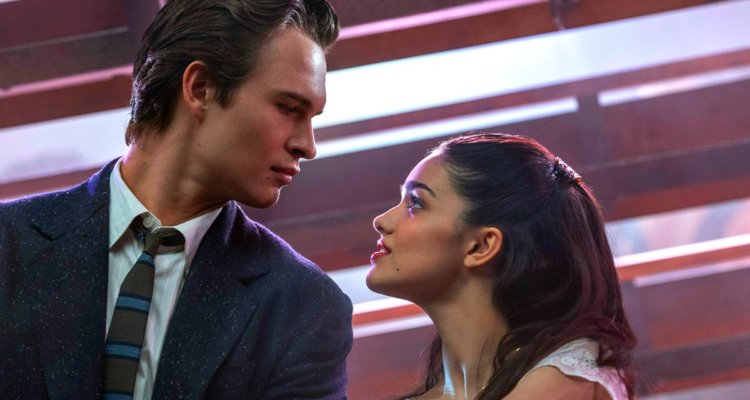How badly can a single performance wreck an entire film? This is the unfortunate question prompted by Steven Spielberg’s new film adaptation of “West Side Story,” a dazzling and energetic movie musical that features, at its center, a performance with all the charisma of a bump on a log. The perpetrator is Ansel Elgort, cast in the leading role of Tony, and he’s absolutely dull as toast — his delivery is flat, his tics and affectations are too contemporary, his expressions are wooden, and he suffers from a total lack of credibility. He’s never not just an actor reciting his lines and doing so poorly. (This is not a new problem.) The accusations of sexual misconduct leveled at Elgort after the film’s completion cast a distressing pall over his performance, but one also can’t help but wonder why such a mediocre actor was cast in the first place.
But once you look past Elgort — which is a big ask — “West Side Story” is a stunner, an engaging and entertaining picture that not only recreates a classic of the musical stage and screen but rethinks it. The story remains the same: Tony (Elgort) is one of the founding members of the Jets, a street gang of white kids in the San Juan Hill neighborhood of New York City, recently out of jail and trying to straighten up. But at a school dance, he locks eyes with Maria (Rachel Zegler), the younger sister of Bernardo (David Alvarez), the leader of the Jets’ Puerto Rican rivals, the Sharks.
“Do you wanna start World War III?” asks Maria’s best friend, and Bernardo’s girlfriend, Anita (Ariana DeBose), and that’s not much of an exaggeration; the stakes are just as high, for these teenagers and their small circle. And thus, this streetwise “Romeo and Juliet” is brought back to life, and in a neat trick, is given a modern sensibility without being “updated.” Tony Kushner’s screenplay adaptation keeps the late 1950s setting, but makes the conflicts more pointed and explicit; the first big rumble follows the Jets defacing a Puerto Rican flag mural, and in explicating the frustrations and motivations of these “white working class” kids, Kushner manages to subtly point towards contemporary racial conflict without hitting us over the head. And in some of the darker moments — like Riff (the excellent Mike Faist) pressing his forehead into the barrel of a pointed gun and growling “You might as well” — Kushner gets at the quiet nihilism just under the shiny surfaces of the city.
His script makes other, welcome modifications as well; the shuffling of a few numbers, here and there, the remaking of Tony’s mentor into a senior woman (mostly to give Rita Moreno a role in this film as well, and she crushes it), that kind of thing. His most ingenious addition is incorporating Robert Moses’ notorious “slum clearance” programs into the narrative — specifically, the buildings that were destroyed to make way for Lincoln Center, a project that director Robert Wise took advantage of to stage the opening scenes of the original, 1961 film version of “West Side Story.” It’s a clever case of subtext made text.
DeBose, a Broadway vet with few screen credits, is electrifying as Anita, a role where (thanks to Moreno’s iconic work) you really have to put up or shut up. She does the former; it’s a star-making performance. That goes double for Zegler, who’s making her film debut here, and displays an incandescent screen presence — she shines brightly enough in her two scenes with Elgort to illuminate both of them.
Of course, we go see a movie like this for the musical sequences, and they’re marvelous. The choreographer is the gifted Justin Peck, and it’s not just that the dancing is well-staged — it’s witty, composed and cut for maximum enjoyment and amusement. I found myself giggling at the sheer joy of it all; “When You’re a Jet” is fast and furious, “America” is vibrant and spiky, and “Office Krupke” is staged with just the right mixture of humor and menace.
None of this comes as a surprise, considering the director — hell, the surprise is that it took Steven Spielberg this long to make a full-on musical, though the musical sequences he staged in “1941” and “Indiana Jones and the Temple of Doom” were those films’ undisputed highlights. Watching “West Side Story,” I was reminded of Pauline Kael’s anecdote of “an older Hollywood director” (some surmised Hitchcock) telling her, of Spielberg, “He must never have seen a play; he’s the first one of us who doesn’t think in terms of the proscenium arch. With him, there’s nothing but the camera lens.” This observation is particularly striking when watching him adapt a stage musical, an enterprise conceived specifically for that proscenium arch; he will absolutely not allow it to invade his frame. Janusz Kaminski’s camera is in constant motion, zipping around the action, getting under or over it, plunging headlong into it; he loves to move that lens around the actors, circling them the way their characters circle each other.
The whole thing moves like a freight train, its 156 minutes passing in barely a breath, and that breakneck pace, combined with the expressionist aesthetic and candy-colored imagery, reminds us that blockbusters don’t have to be these lumbering processions of greyscaled dreck. It’s a rarity, a big-budget holiday movie with style and pizzazz. Shame about that leading man, though. [B]

